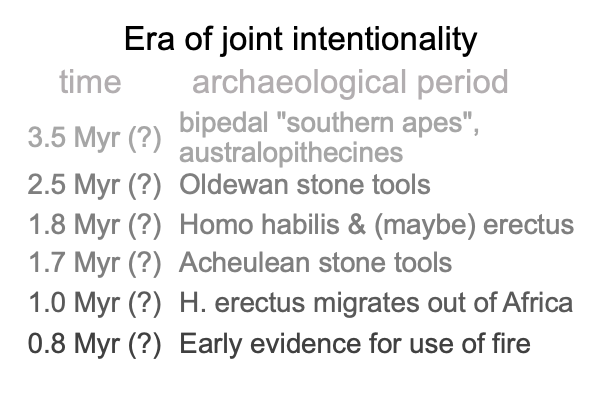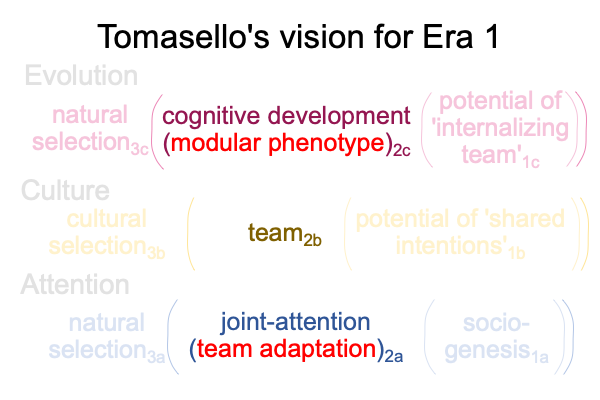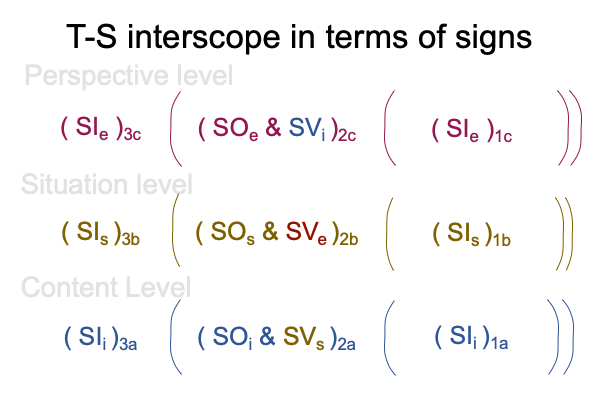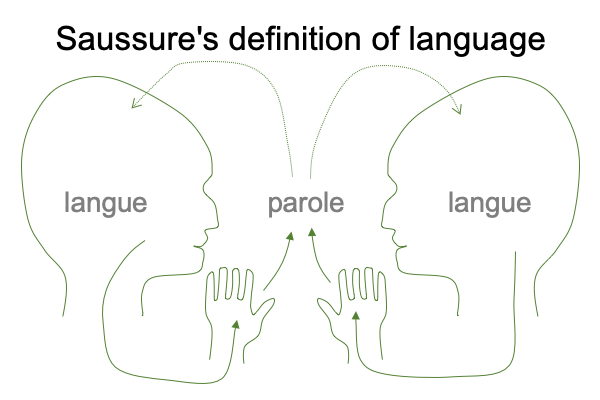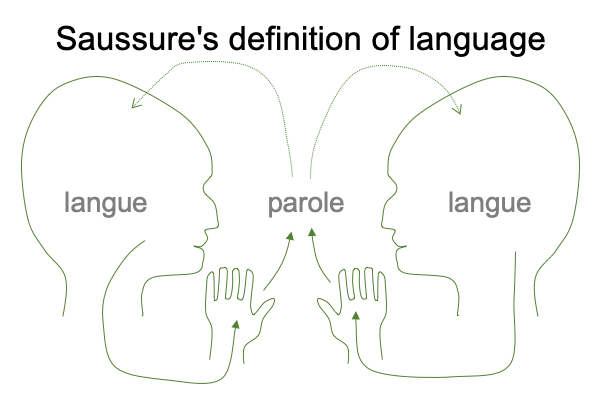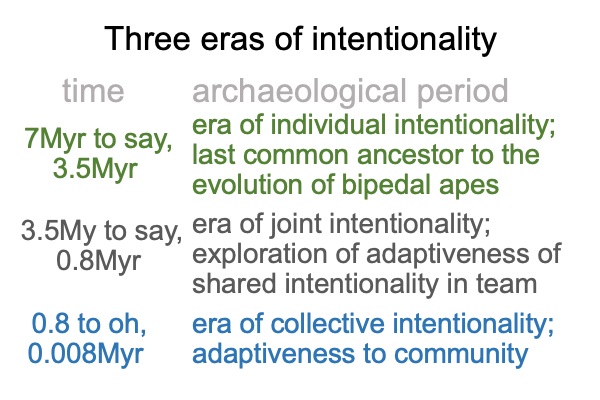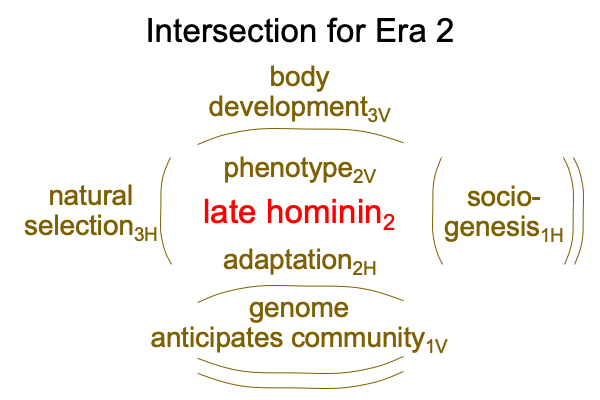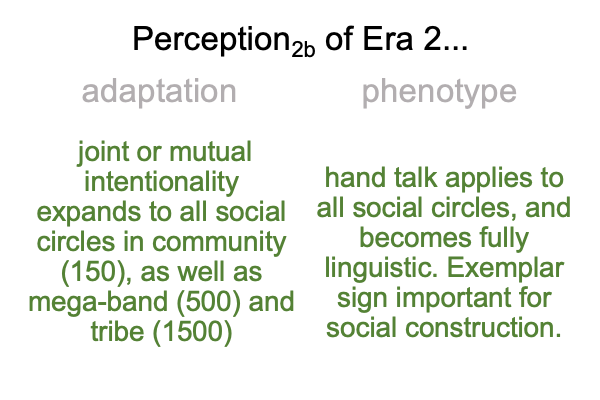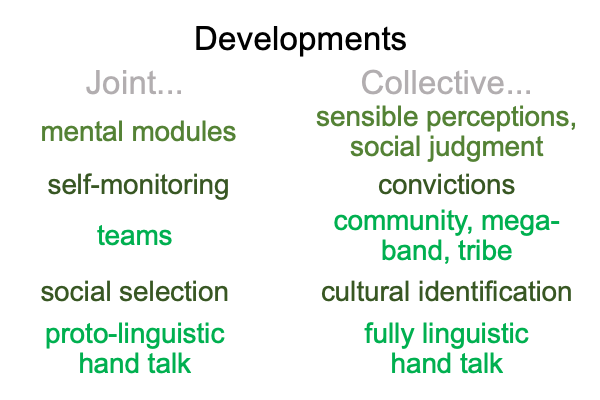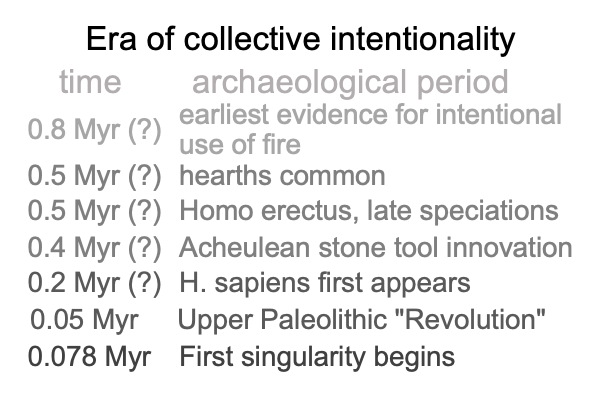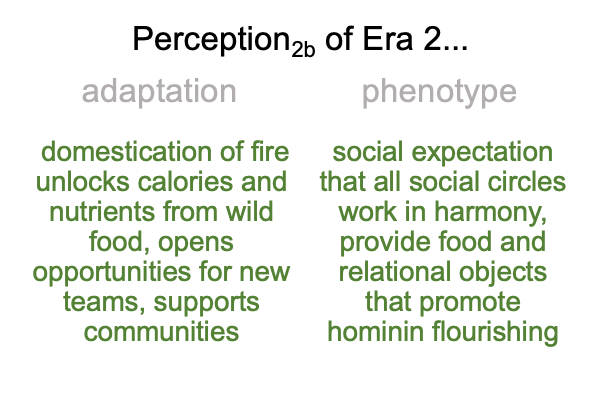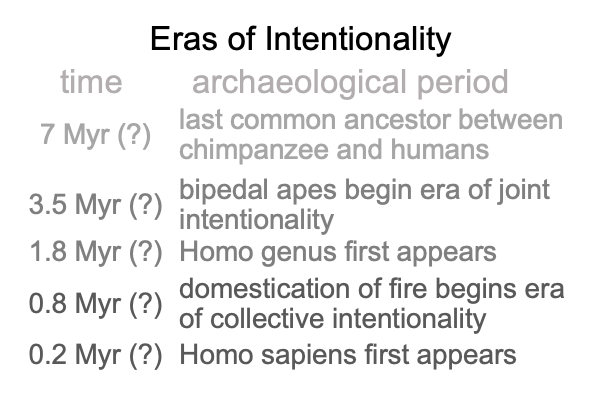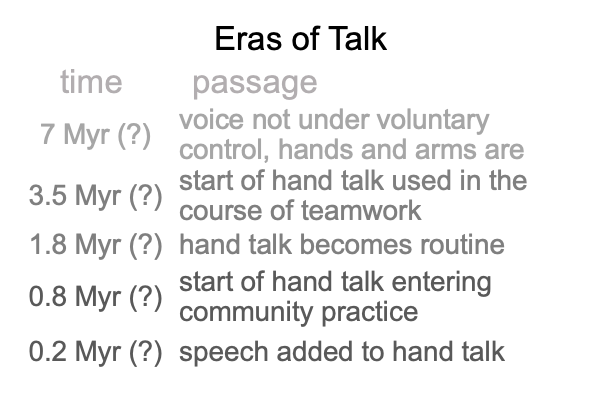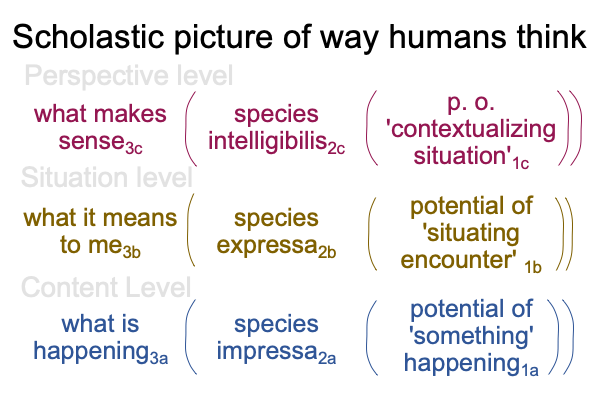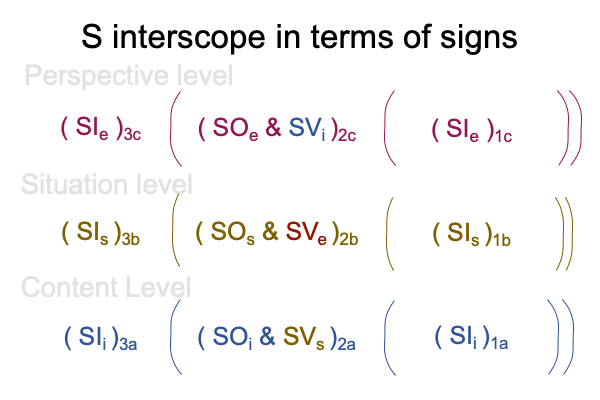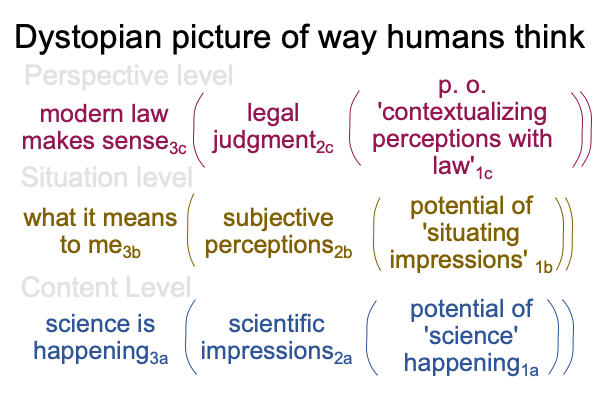Looking at Michael Tomasello’s Book (2014) “A Natural History of Human Thinking” (Part 12 of 22)
0274 My game of labeling adaptation and phenotype continues.
I imagine the following intersection for human evolution entering into my slot for species impressa2a. I ask myself, “What is a sensible interpretation of the phenotype and adaptation for the era of joint intentionality, lasting from the beginning of bipedalism to the domestication of fire, covering from around 3.5 to around 0.8Myr?
Here is the topic for chapter three.

0275 What is the phenotype2V and the adaptation2H for the Era of Joint Intentionality,
What about my perception2b?
0276 To begin, I consider contemporary chimpanzees hunting for monkeys. They do not play this exercise when food is scarce. Rather, they play for sport. Hey, there are some monkeys around here. Maybe, I… er… “we” can capture one and eat it raw. Yes, each chimpanzee entertains the same judgment and is willing to go along with the others.
Off the troop of the willing goes. Once they get around an isolated monkey, each positions himself to block an escape route. The monkey takes one ill-fated path and one of the chimpanzees gets hold of it and then, runs off, in order to eat as much of the little critter as possible before the others demand their share.
0277 Does that sound like shared intentionality?
Yes and no.
Clearly, human collaborative efforts are very different. Humans are willing to share.
Aren’t they?
0278 Here is a figure with my perception2b.

0279 Tomasello envisions the opening of a new foraging niche, where collaboration pays off. Mixed forest and savannah offer widely spaced, occasionally and locally rich, foods. Bipedalism solves the widely spaced problem. But, that is not enough. One cannot walk and forage at the same time.
Bipedalism keys into a proximate niche.
Collaboration keys into an ultimate niche.
Why does collaboration become practical?
Rather than one individual foraging within a band, a team separates from the band and forages for its specialty. If successful, that team gathers more than each member of the team can eat. The team refrains from eating their full and falling asleep. Why? The team is on a mission. Gather food for me and my friends. That is the obligation. We work for food.
When more than one team operates at the same time, then collaborative foraging requires more than cooperation within each team. It requires that teams cooperate as well. Thus, the seeds of the next era are already germinating within the Era of Joint Intentionality.
0280 Tomasello calls the novel foraging strategy, “obligatory collaborative foraging”.
Of course, the modern term, “obligatory” means not having a choice.
But, that is not the real insight. The real insight comes when “obligatory” means “obligation” and “obligation” means “responsibility”.
Teammates are responsible for one another. Each member is more productive (and more likely to survive) when responding to content (the tasks at hand, clues to nearby predators, and so forth) and to situation (whether I or my teammate is near a cache or near danger). Intentional signs are valued.
0281 As noted by Tomasello, hominin intentional signs build on the pantomime and pointing gestures of the prior era. Indeed, these intentional signs become more and more routine. At some point, they may be described as “hand talk“. Hand talk consists of icons and indexes that are sufficiently distinct from one another that they are easily interpreted in the course of a team’s activities.
Hand-talk couples the sign-objects of intentional signs with the sign-vehicles of specifying signs. Hand-talk is recognizable because it starts as iconic (pantomime) or indexal (pointing) natural signs. Hand-talk gestures become more and more facile, in both generation and interpretation, when they become distinct from one another. A third natural sign, the symbol, enters into the picture because symbols are distinct from one another. A symbol is a sign-relation whose sign-object is based on habit, tradition, convention, law and so forth. Symbols must be different from one another in order to… um… serve as symbols.
0282 Here is one way to think about the coupling of intentional sign-object and specifying sign-vehicle.
The intentional sign-vehicle is a judgment. Judgments are purely relational beings. Therefore, they must be symbolic. So, if one judgment occurs over and over again, then it is likely to be different…. er… distinct from other judgments that occur over and over again. So, the sign-object of the interventional sign will introduce symbolic features to hand talk.
The specifying sign-relation prefers icons and indexes, in order for the reference to be grounded in the real. Icons and indexes inherently specify their referents.
Indeed, when a symbol is presented, reference is not obvious. So, hominins prefer icons and indexes to initiate a specifying sign-vehicle, rather than the fact that one gesture-word is distinct from other gesture words. Implicit abstraction connects hand-talk gesture to its referent. The reference is recognized as something that one can picture or point to. Grounded reference facilitates sensible construction.
When a team members are out and doing their business, they are not playing word-games. Sensible construction is the order of the day. Everyone should have the same perception when a teammate hand-talks.
0283 With this said, I would like to return to the game of presenting my perception of adaptation and phenotype, once again.

0284 Okay, joint attention adapts to a proximate and to an ultimate niche.
In terms of diverse proximate niches, each successful team produces its own specialized adaptations. Each successful team gets better and better over generations. Consequently, each team produces divergent evolution.
In terms of an ultimate niche, all teams have one feature in common. Members of the team engage in hand talk. So, even though each team develops its own “language”, all the team-languages have the common niche of triadic relations. In particular, the interventional and specifying signs constitute the niche for all team-related proto-languages. As such, all teams undergo convergent evolution.
0285 What about the adaptation of shared intentionality?
Joint attention is behavioral and describes how each team operates.
Shared intentionality is more… um… psychic and describes how each member within each team figures out what everyone else on the team is thinking at the moment.
0286 Surely, this adaptation has something to do with the exemplar sign.
In the scholastic exemplar sign, my species expressa2b (SVe) stands for a species intelligibilis2c (SOe) in regards to a normal context asking, “Does this make sense?”3c operating on the potential of ‘contextualizing the situation’1c (SIe).
In Tomasello’s exemplar sign, my perception2b (SVe) stands for a judgment2c (SOe) in regards to the normal context of joint attention3c operating on the potential of ‘shared intentionality’1c (SIe).
0287 Does that call for another perception2b for era one?
Here is a picture.


